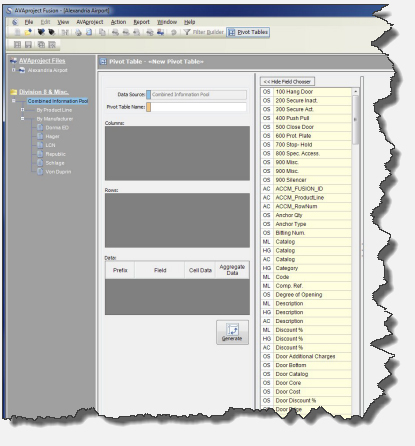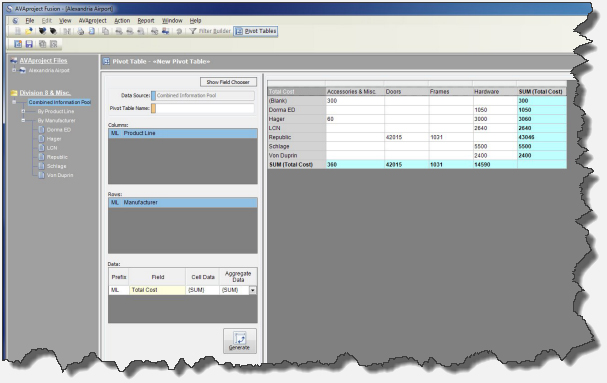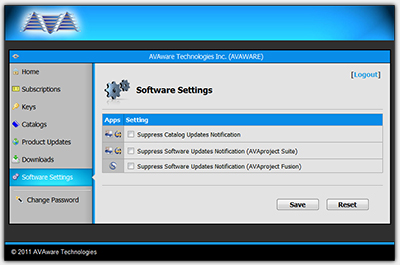
AVAproject Fusion Series:
No. 4, Pivot Tables - 'Business Intelligence' for Project Data
AVAware Article Featured in June 2011 DHI Magazine
AVAware.com’s Expanded Customer Login Area Brings a New Level of Control to AVAproject Users
Division 10 Catalog Cuts Now Available
AVAproject Tip: Copying Data Between Schedules with Differing Layouts
DHI 2011 Is Coming Soon & We Need Your Help to Prepare!
Calling All contractERP Users

 U.S. Price Books: U.S. Price Books:
- Adams Rite
- Ceco
- Dorma D.C.
- Dorma E.D.
- Dorma L.K.
- Falcon
- Hager
- K2
- Norton
- Pioneer
- Rediframe
- Roton
- Sargent
- Select
- Steelcraft
- Trimco
- Yale
 Canadian Price Books: Canadian Price Books:
|

|

|
AVAproject Fusion Series: No. 4, Pivot Tables - 'Business Intelligence' for Project Data
|

|
This is the fourth in our special series of articles profiling our newest product offering: AVAproject Fusion.
Fusion is about mastering your data. Information from AVAproject or virtually any other Windows-compatible data source can be brought together, manipulated, reported on and reformatted for use in other applications. See your data any way you can imagine it.
|
|
In previous months we discussed the basics of how project files, created in AVAproject, can be brought in to Fusion. Our most recent article offered a brief introduction into the power of Filters to selectively extract required data from the project as a whole.
The power of AVAproject Fusion, however, does not end with simply extracting and viewing data – it only begins there. Fusion is a tool that allows data to be re-organized for the purposes of reporting and analysis. In data processing circles, this is known as “Business Intelligence”.
|
Business intelligence (BI): refers to computer-based techniques used in identifying, extracting, and analyzing business data, such as sales revenue by products and/or departments, or by associated costs and incomes.
|
|

The AVAproject Fusion Pivot Table Interface
|
|
One of the most versatile tools in the data processor’s arsenal is a flexible form of tabular report called a “Pivot Table”. Although pivots tables have been in use for decades, the term was first seen in the early 1990s with the release of Lotus Improv. Since then, many business applications have featured their own variations of the pivot table methodology. The most common one is the implementation seen in Microsoft Excel. The Pivot Table had become so popular for Microsoft, that they have released a new and improved tool as part of their 2010 Excel offering. Not to be outdone by the world’s largest software company, we
|
have created our own powerful implementation of the pivot table that allows for the detailed analysis of AVAproject data.
In essence, pivot tables are expressions of data on an X-Y grid. Data from any one or more fields can be cross-referred against data from any other field or fields. Put simply, it’s “anything against anything”.
When the Pivot Table Builder is selected, three boxes (known as “drop zones”) as well as a list of all available data fields are shown.
If, for example, one wanted to generate a breakdown of product
|
costs for each manufacturer by product, this could be achieved in seconds using the Fusion Pivot Table Builder. Simply drag the “Manufacturer” field in the “Row” box and the “Product Line” field in the “Column” box. In order to report on total costs, drag the “Total Cost” field into “Data” box. Upon clicking on “Generate”, a detailed pivot table (similar to the one below” is generated.
A row was created for each unique value found in the “Manufacturer” field. Similarly, a column was added for each unique value found in the “Product Line” field. The cells in the body of the table report the total of the “Unit Cost” field for
|

The AVAproject Fusion Pivot Table Interface
|
|
each line of data whose data values correspond to the row and column header cells.
This is only one simple example of the power offered by pivot tables. This sample table could, for example, be refined even further by breaking down “Product Line” by material, gauge, label or any other aspect of the project data. The possibilities are absolutely limitless. Fusion has taken the traditional pivot table tool to yet another level by allowing for multiple fields to be tabulated in the data section simultaneously.
|
As an example, “Total List” can be added to this sample table, to allow costs and list prices to be tabulated side-by-side.
The possibilities for reporting using Fusion Pivot Tables is truly limited only by the imagination of the user. AVAproject Fusion currently ships with a comprehensive library of pre-built pivot tables that can be run against any project’s data. Moreover, the library functionality within Fusion allows users to create and distribute their own libraries of pivot tables, filters and
|
view styles. Perhaps in the future, we’ll even see the establishment of online forums where users can post and exchange libraries they’ve created for use in Fusion.
|

|
AVAware Article Featured in June 2011 DHI Magazine
The architectural openings industry's premiere publication, Doors & Hardware Magazine, featured yet another article from AVAware in its June 2011 issue.
"Software in an Integrated World", authored by AVAware President & CEO Paul Kirsch examines the various interpretations of the term "integration" as it applies to software. It also provides a brief history of software integration, and how modern approaches and technologies came to be.
Stay tuned for upcoming AVAware features in the DHI Magazine.
|
|
AVAproject users are already familiar with the powerful and convenient Customer Login Area of the AVAware website. For those who haven’t yet had the pleasure, the Customer Area is an online “control panel” of sorts that provides access to several resources surrounding the use of AVAproject. Upon logging in, customers are taken to a page similar to the one depicted to the left.
With a single click, clients can review and manage their account information, users, subscriptions, etc. In addition, catalog updates, software updates and other
|

The AVAware.com Customer Login Area Home Screen
|
|
customer-specific downloads are accessible through this page.
All the data in the Customer Login Area is maintained in an online database mirror that is directly linked to our internal company data server. Customers can see
|
data in real-time, as it becomes active. Time-sensitive items such as subscriptions and releases are displayed “live” with no time lag whatsoever.
The newest addition to this powerful set of resources is the
|
“Software Settings” page. The purpose of this page is to offer company administrators access to parameters that govern the operation of AVAware software in all their locations and for all their remote users. This is obviously a greater issue for larger
|

The AVAware.com Customer Login Area Catalogs Section
|
|
customers that have users spread out in multiple locations. The separation of users and operation on multiple localized networks
|
company personnel can periodically check for updates by logging into the AVAware website or by using the manual update check facility.
|
Typically, the ability to have users in multiple locations and mobile computing comes at the expense of not being to
|
|
creates real challenges for companies that wish to administer all of their users from a single location. This new web applet is AVAware’s answer.
The first item we addressed through online settings was that of update notifications. Many companies wish to centrally control the distribution of software and catalog updates to its users. Whether it be maintaining consistent software versions across the enterprise or to consistent pricing with structured catalog distributions, many larger companies prefer to have their I.T. staff distribute updates on their schedule.
|

The New AVAware.com Customer Login Area Software Settings Section
|
|
Although AVAproject users can certainly deactivate update notifications through the Preferences dialog, the web applet puts this control in the hands of the administration. By selecting the options on this page, update notifications can be disabled at the source. When the suppression option is selected, users will not be notified of software or catalog updates, regardless of their individual settings. Designated
|
Blurring the Line Between “Web” and “Desktop” Applications
The implications of this new feature go far beyond that of simply update notifications. This new settings facility is a precursor to some exciting new technologies that AVAware will be releasing in the near future. Online parameter pages are common place when dealing with web-based or network-based applications.
|
administer it from a central location.
AVAware’s next generation of software will allow companies to “tether” their remote users via the internet. AVAware developers will be working with some of our multi-location installations in an effort to create a new deployment and remote administration tool that we hope to debut later this year.
|
|

|
|
In response to the increasing demand for AVAware’s Division 10 Catalog library, three new collections of catalog cuts are now available as a supplement to the collection.
Catalog cuts are now available for:
- Bobrick (US & Canada)
- Hadrian (Canada)
- Meek (US)
These catalogs were selected based on popularity and the
|
availability of manufacturer cut sheets. Naturally, additional catalogs will be added to the collection based on customer demand.
Like their Division 8 counterparts, D10 Catalog Cuts feature high-quality vector-based graphics and text. They can be rendered at virtually any size and resolution with no degradation in image quality. Also, like the D8 cuts, the product sheets are linked directly to the products in the electronic
|
catalogs. Applicable catalog cuts are automatically selected by AVAproject and inserted into the submittal document when the corresponding products are used in a given project.
D10 Catalog Cuts are available through a separate subscription offered in conjunction with the D10 Catalog library. Any AVAproject users interested in obtaining the D10 Catalog Cuts may do so by contacting AVAware support.
|

|
|
Virtually every PC user has performed a cut and copy operation at one time or another. Schedules within AVAproject look and feel very similar to a traditional Excel-type spreadsheet. Appearance, however, is where the similarity ends.
When rows are copied within a traditional spreadsheet, cells are pasted back in the exact same order they were copied in. In other words, to copy rows from one sheet to another, the column layout of the two sheets must be identical. This is NOT the case with AVAproject. One of its most convenient (and well hidden) features it the “smart” clipboard.
When rows are copied in AVAproject, they are actually copied twice. As with most Windows applications, data is copied to the standard Windows clipboard. This facilitates the pasting of data to outside applications, such as Excel or other spreadsheet applications. AVAproject also copies data to its own internal clipboard. This allows additional information about the copied data to be stored along with it. When a paste operation is performed within AVAproject, the data is pasted back from the internal clipboard and automatically reorganized to match the format of the destination schedule.
For example, if the highlighted rows below are copied...

An AVAproject Openings Schedule with multiple rows highlighted
...they can be pasted to a schedule with a differing layout. (as depicted below).

A second AVAproject Openings Schedule with a different column layout after rows have been pasted
In addition, when entire rows are selected and copied, the entire row is copied – including all the data in the hidden columns. In the preceding example, notice that several columns were displayed in the destination schedule that were hidden in the source.
The “smart” clipboard eliminates the need to re-arrange columns within schedules, lists and groups to facilitate the movement of data between them. This process also works when data is copied from one project to another within a single instance of AVAproject.
|
|
DHI 2011 Is Coming Soon & We Need Your Help to Prepare!
|
|
Once again, the time has come to make preparations for the Door and Hardware Industry’s premier annual event – the DHI Annual Conference and Exposition. 2011 marks this auspicious event’s 36th year and will be hosted at the Javits convention Center in New York City.
|

|
|
Due to time constraints of a two-day trade show, we need to make effective use of the time allowed. As such, we’re asking both our current customers and those interested in learning more about AVAware products and services to take a few moments to complete a very brief online survey. Whether you currently plan to attend the show or not, we would appreciate your input so that we can tailor our schedule of events and presentations to greatest interest of industry members.
To complete this short survey, please click here.
Thank you very much in advance for your assistance.
Sincerely,

Paul S. Kirsch,
President & CEO
|
Calling All contractERP Users
|

|
contractERP is an ERP/accounting system developed and marketed by Access Information Technologies (Access IT) of Farmingdale, NY. Access IT’s contractERP is built on top of Microsoft’s Navision product and has been used by AVAware customers since 2004.
|
|
In the past, third party developers facilitated the connectivity between AVAproject and contractERP. As time went on, the number of AVAware customers that adopted contractERP grew. In response to this and requests from many of the users themselves, AVAware developed our own contractERP export facility for use with AVAproject.
Since those early days, the number of AVAproject / contractERP users has grown considerably. Today, AVAware is one of, if not “the” most widely used detailing and estimating system used by contractERP customers, making up a significant portion of contractERP’s entire customer base, and including some of their largest
|
clients in both the United States and Canada. As such, it is only fitting that we take the initiative to help enhance the integration between these two successful applications.
Traditionally, AVAproject has performed a straight export of project data into contractERP with no attempt to modify the nature of it whatsoever. After several discussions with some of our common clients, AVAware’s developers have begun to explore ways in which the contractERP export facility could be enhanced to provide additional options for contractERP users. Even beyond this, our team has even explored the possibility of enhancing the exports generated from other detailing and estimating systems as
|
well. At this point, this is nothing more than speculation and brainstorming – but at AVAware that’s usually the beginning of some very creative projects! We are interested in hearing from any contractERP users that would be interested in taking part in an AVAware / contractERP users group. Once again, there are no definite plans except to establish some sort of forum in which to exchange ideas and experiences.
Whether you are an AVAware user or simply hope to be one soon, and have any interest in communicating with other contractERP users, please send us an email.
Thank you!
|
|
We welcome any questions, comments or suggestions about any topic mentioned in this edition of AVAwire. Please visit our website for more information, or contact us directly at (416) 239-9099.
|
|